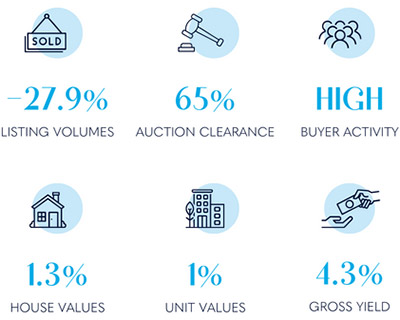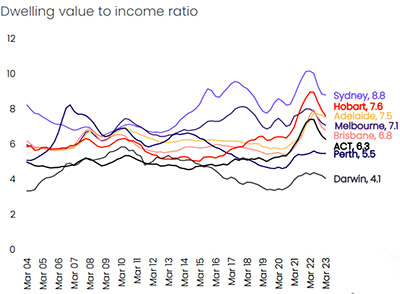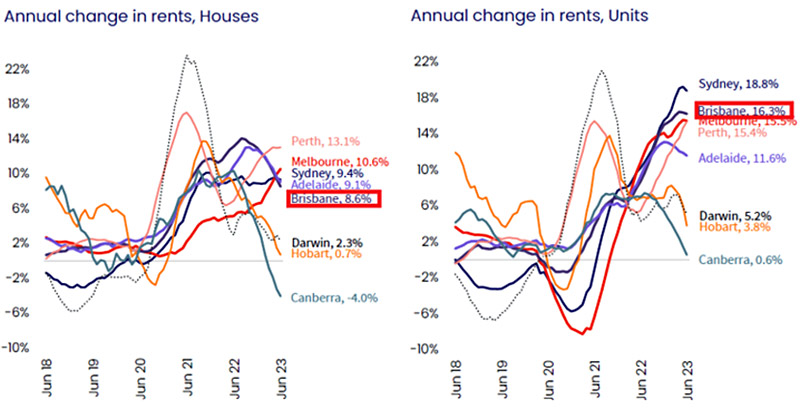Brisbane now second best performing capital for price growth
Brisbane property's apparent slide from favour late last year appears over, with the city's real estate market taking off again and sitting behind only one other state capital.
Brisbane property buyers continue to display a robust appetite for real estate, notching up a fourth straight month of price growth.
Mirroring the same wider national home value trend, property prices in the Queensland capital also grew in June at a slightly lower rate than the previous month.
Detached houses led the recovery, outpacing the growth rate of units for the second month in a row.
Although that rate of growth in June slightly eased compared to May, it remained strong despite the impact of rising interest rates and school holidays on the overall market.
It could be considered remarkable that buyer numbers remain resilient, considering the low consumer sentiment reminiscent of the initial shock of Covid and the Global Financial Crisis that prevailed at the start of the year.

The auction market in Brisbane showed stability from May to June. According to Apollo Auctions, the average clearance rate in June was 65 per cent, slightly lower than May’s 66 per cent.
While the average number of registered bidders per auction decreased slightly from 3.9 in May to 3.7 in June, there was a notable increase in the percentage of registered bidders who actively participated and made bids, rising from 60.3 per cent to 63.95 per cent across the two months.
Brisbane is now the second best performing property market among Australia's capitals, sitting just behind Sydney according to the June price movement data.
While some individuals may choose to sell due to rising holding costs, particularly those transitioning from fixed interest rates in the latter months of 2023, the existing depth of buyers appears sufficient to absorb such changes.
Unless there are substantial shifts in demand drivers, it is unlikely Brisbane will witness further price declines in the short term.
New listings scarce in Brisbane
Again reflecting the broader national situation, the issue of limited supply continues to dominate the Brisbane market.
According to CoreLogic, new listings entering the market are 30 per cent lower than this time last year, while total listings in Brisbane have decreased by 15 per cent from a year ago.
This scarcity of available properties poses a significant challenge for Brisbane property buyers, as despite their willingness to make transactions, they struggle to find suitable options to purchase.
Sellers in Brisbane have been hesitant to put their properties on the market, primarily due to the lack of confidence in finding a new property to buy or rent.
In an exceptionally competitive rental market, the possibility of renting as an interim solution between a sale and purchase is challenging and often impossible.
The absence of widespread panic among sellers has resulted in a situation where they refrain from taking action, further tightening the market.
Options for buyers vary across different suburbs.
According to PropTrack data, certain suburbs experienced a significant decrease in new listings compared to the previous year.
Marsden, located in Brisbane’s south and known for its secondary school catchment zone, witnessed a decline of 64 per cent in the year to May.
Similarly, Yeronga and The Gap also had substantial drops in year-on-year listings, with 59 per cent and 55 per cent fewer properties available for sale, respectively.
On the other hand, some suburbs provided more choices for buyers.
Ashgrove in Brisbane’s inner northwest saw a remarkable increase of 108 per cent in year-on-year listings. Ascot and Auchenflower were also big movers over the year, each with 64 per cent more options.
Real estate buyers making compromises
The ongoing increase in interest rates is significantly affecting borrowing capacity, which in turn impacts the property demand, however, what we’re observing is that individuals are making compromises based on affordability, rather than delaying their property purchasing decisions.
Compared to other capital city markets, Brisbane property remains more affordable than most.
The dwelling value-to-income ratio for Brisbane is lower than that of Sydney, Hobart, Adelaide, and Melbourne. It’s little wonder buyers from other east coast capitals are increasingly drawn north.

Source: Corelogic.
According to CoreLogic, Brisbane property buyers need to allocate 40 per cent of their household income to cover mortgage payments.
While high and placing the average borrower in the mortgage stressed category, this percentage is 52 in Sydney, 45 in Hobart, and 44 in Adelaide, making Brisbane the most affordable capital city on the east coast.
This affordability factor has contributed to an influx of buyers relocating from the south in recent years.
Many of these newcomers have sold their homes in New South Wales or Victoria and found equally desirable properties in Brisbane, with substantial savings remaining.
Alternatively, some buyers are upgrading their homes to enhance their lifestyle, fully aware that they can stretch their budget further and secure a high-quality property in Brisbane.
Units no longer star of the show in Brisbane
In June, the values of dwellings in Greater Brisbane rose by 1.3 per cent, according to CoreLogic, translating to a quarterly growth rate of 3 per cent. The median value of a dwelling in Greater Brisbane now stands at $725,397.

Source: Corelogic.
Additionally, PropTrack data reinforces this positive trend, indicating a 0.08 per cent increase in dwelling prices for the month across Greater Brisbane. The median value of dwellings by PropTrack is recorded at $731,000.
Brisbane’s housing market has shown strong performance for the second consecutive month, with median house values outpacing unit growth.
In June, median house values experienced a 1.3 per cent increase, resulting in a quarterly growth rate of 3 per cent. The current median value for a house in Greater Brisbane stands at $806,781, according to CoreLogic.
PropTrack data also confirms positive growth in the housing market, reporting a 0.18 per cent increase in house prices for June.

Source: Corelogic.
In June, the median value for units in Greater Brisbane were outpaced by houses, recording a 1 per cent increase while reaching a new record median of $512,262.
This growth aligns with the housing market on a quarterly basis, which has also now experienced a 3 per cent increase over the last three months.
Over the past year, units have still outperformed houses in Brisbane, with a 1.5 per cent increase in median values compared to a 9.9 per cent decrease in housing values, as reported by CoreLogic.

Source: Corelogic.
However, in contrast to the above information, PropTrack data presented a slight negative change in median unit prices for Brisbane in June, recording a 0.5 per cent decline. The current median value for units, according to PropTrack, stands at $546,000.
Signs of mercy in tight rental market
According to the most recent data from SQM Research, the vacancy rates in Brisbane have remained stable from April to May, staying at 1 per cent.
While the overall city-wide trend remains unchanged, certain regions within Greater Brisbane are experiencing an increase in vacancy rates.
The Ipswich region, for instance, has seen a rise from its lowest point of 0.5 per cent in August last year to the current vacancy rate of 1.5 per cent. Similarly, the Brisbane CBD, which previously had a low vacancy rate of 0.9 per cent in February, has been consistently increasing and now stands at 1.4 per cent.
Brisbane is still witnessing robust international demand for rental properties.

Source: Corelogic.
Net overseas migration is projected to reach 400,000 this fiscal year, marking a remarkable surge of nearly 27 per cent compared to the previous record set in 2008. It is worth noting that the majority of international migrants prefer to rent rather than buy when they first arrive in Brisbane.
According to data from PropTrack, the top countries conducting rental searches in Brisbane include New Zealand, United States, United Kingdom, India, China, and Singapore.
Notably, the return of Chinese students to Australia has had a significant impact on the increase in rental searches, as confirmed by PropTrack data.
Over the past 12 months, house rents have increased by 8.6 per cent, as reported by CoreLogic, while unit rent growth has nearly doubled at 16.3 per cent.
Despite these trends, rental yields have remained steady this month, with gross yields for houses holding at 4 per cent and gross yields for units at 5.4 per cent.





















